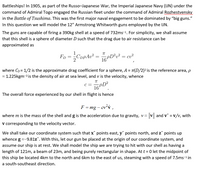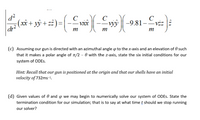
Elements Of Electromagnetics
7th Edition
ISBN: 9780190698614
Author: Sadiku, Matthew N. O.
Publisher: Oxford University Press
expand_more
expand_more
format_list_bulleted
Concept explainers
Question

Transcribed Image Text:Battleships! In 1905, as part of the Russo-Japanese War, the Imperial Japanese Navy (IJN) under the
command of Admiral Togo engaged the Russian fleet under the command of Admiral Rozhestvensky
in the Battle of Tsushima. This was the first major naval engagement to be dominated by "big guns."
In this question we will model the 12" Armstrong Whitworth guns employed by the IJN.
The guns are capable of firing a 390kg shell at a speed of 732ms-1. For simplicity, we shall assume
that this shell is a sphere of diameter D such that the drag due to air resistance can be
approximated as
1
FD
CopAv²
where Cp = 1/2 is the approximate drag coefficient for a sphere, A = T(D/2)2 is the reference area, p
- 1.225kgm-3 is the density of air at sea level, and v is the velocity, whence
C =
16
pD?
The overall force experienced by our shell in flight is hence
F = mg – cvv ,
where m is the mass of the shell and g is the acceleration due to gravity, v= v and v^ = v/v, with
v corresponding to the velocity vector.
We shall take our coordinate system such that x^ points east, y points north, and z^ points up
whence g--9.81z^. With this, let our gun be placed at the origin of our coordinate system, and
assume our ship is at rest. We shall model the ship we are trying to hit with our shell as having a
length of 121m, a beam of 23m, and being purely rectangular in shape. At t = 0let the midpoint of
this ship be located 4km to the north and 6km to the east of us, steaming with a speed of 7.5ms-1 in
a south-southeast direction.

Transcribed Image Text:d?
xx
C
C
-9.81-–viz î
VXX
vyy
m
m
m
(c) Assuming our gun is directed with an azimuthal angle p to thex-axis and an elevation of 0 such
that it makes a polar angle of T/2 – 0 with the z-axis, state the six initial conditions for our
system of ODES.
Hint: Recall that our gun is positioned at the origin and that our shells have an initial
velocity of 732ms-1,
(d) Given values of 0 and p we may begin to numerically solve our system of ODES. State the
termination condition for our simulation; that is to say at what time t should we stop running
our solver?
Expert Solution
This question has been solved!
Explore an expertly crafted, step-by-step solution for a thorough understanding of key concepts.
This is a popular solution
Trending nowThis is a popular solution!
Step by stepSolved in 2 steps with 2 images

Knowledge Booster
Learn more about
Need a deep-dive on the concept behind this application? Look no further. Learn more about this topic, mechanical-engineering and related others by exploring similar questions and additional content below.Similar questions
- Hydro Tasmania has initiated the Battery of the Nation (BotN) strategic initiative to investigate and map out future development opportunities for the State of Tasmania to make a bigger contribution to a future National Electricity Market (NEM). The Tarraleah scheme redevelopment pre-feasibility study was undertaken through this initiative, with funding support from ARENA under the Advancing Renewables Program. For this assignment problem you will be using your knowledge of hydro power to: (1) estimate extended specifications for a new power station on the left bank of the Nive River opposite the existing power station; and (2) to reverse engineer specifications for the Pelton turbines currently installed at the Tarraleah power station. The pre-feasibility design team established basic parameters of a new power station to comprise two Francis turbines with a design flow of 20 m³/s (total 40 m³/s), a net head of 305 m and an installed capacity of ~57 MW (total 113 MW). The Tarraleah…arrow_forwardWhat is the effect of acceleration on a beam of light shone horizontally at one wall?arrow_forwardDon't Use Chat GPT Will Upvote And Give Handwritten Solution Pleasearrow_forward
- An electric hot water heater consumes 3.1 kilowatts of electricity and converts it to heat. How long will it take the water heater to heat a 67 gallon tank of water from 10 degrees Celsius to 50 degrees Celsius? (1 kilogram of water is 0.37 gallons, 1 Calorie = 4200 J). It may be helpful to refer back to the weekly handout for guidance on this problem. Your final answer should be in minutes (rounded to the nearest 10 minutes).arrow_forward⦁ “God himself could not sink this ship” This is an advertisement for the Titanic, produced in the early 1900s. However, after colliding with an iceberg at dawn on April 15, 1912, two rivers were formed, and out of the 2,200 people on board, 1,500 people, including the captain, sank with the ship. According to a later investigation, the “temperature change theory” (DBTT theory) was the most promising cause of the sinking. Give a brief guess of the cause of the ship's sinking in relation to temperature.arrow_forwardCan someone please help me to solve the following question showing all work. Thank youarrow_forward
arrow_back_ios
arrow_forward_ios
Recommended textbooks for you
 Elements Of ElectromagneticsMechanical EngineeringISBN:9780190698614Author:Sadiku, Matthew N. O.Publisher:Oxford University Press
Elements Of ElectromagneticsMechanical EngineeringISBN:9780190698614Author:Sadiku, Matthew N. O.Publisher:Oxford University Press Mechanics of Materials (10th Edition)Mechanical EngineeringISBN:9780134319650Author:Russell C. HibbelerPublisher:PEARSON
Mechanics of Materials (10th Edition)Mechanical EngineeringISBN:9780134319650Author:Russell C. HibbelerPublisher:PEARSON Thermodynamics: An Engineering ApproachMechanical EngineeringISBN:9781259822674Author:Yunus A. Cengel Dr., Michael A. BolesPublisher:McGraw-Hill Education
Thermodynamics: An Engineering ApproachMechanical EngineeringISBN:9781259822674Author:Yunus A. Cengel Dr., Michael A. BolesPublisher:McGraw-Hill Education Control Systems EngineeringMechanical EngineeringISBN:9781118170519Author:Norman S. NisePublisher:WILEY
Control Systems EngineeringMechanical EngineeringISBN:9781118170519Author:Norman S. NisePublisher:WILEY Mechanics of Materials (MindTap Course List)Mechanical EngineeringISBN:9781337093347Author:Barry J. Goodno, James M. GerePublisher:Cengage Learning
Mechanics of Materials (MindTap Course List)Mechanical EngineeringISBN:9781337093347Author:Barry J. Goodno, James M. GerePublisher:Cengage Learning Engineering Mechanics: StaticsMechanical EngineeringISBN:9781118807330Author:James L. Meriam, L. G. Kraige, J. N. BoltonPublisher:WILEY
Engineering Mechanics: StaticsMechanical EngineeringISBN:9781118807330Author:James L. Meriam, L. G. Kraige, J. N. BoltonPublisher:WILEY

Elements Of Electromagnetics
Mechanical Engineering
ISBN:9780190698614
Author:Sadiku, Matthew N. O.
Publisher:Oxford University Press

Mechanics of Materials (10th Edition)
Mechanical Engineering
ISBN:9780134319650
Author:Russell C. Hibbeler
Publisher:PEARSON

Thermodynamics: An Engineering Approach
Mechanical Engineering
ISBN:9781259822674
Author:Yunus A. Cengel Dr., Michael A. Boles
Publisher:McGraw-Hill Education

Control Systems Engineering
Mechanical Engineering
ISBN:9781118170519
Author:Norman S. Nise
Publisher:WILEY

Mechanics of Materials (MindTap Course List)
Mechanical Engineering
ISBN:9781337093347
Author:Barry J. Goodno, James M. Gere
Publisher:Cengage Learning

Engineering Mechanics: Statics
Mechanical Engineering
ISBN:9781118807330
Author:James L. Meriam, L. G. Kraige, J. N. Bolton
Publisher:WILEY